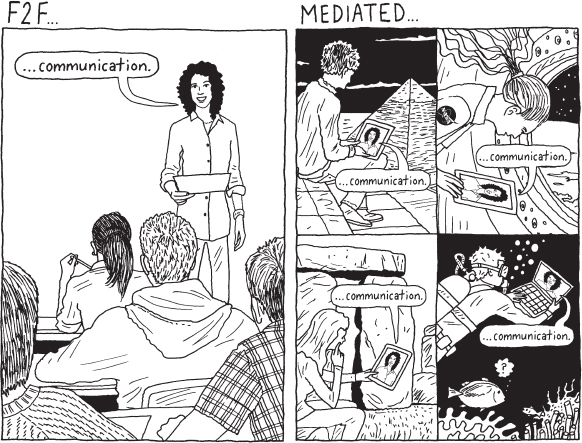MEDIATED PUBLIC SPEAKING
Printed Page 437
15
MEDIATED PUBLIC SPEAKING

Look for the  throughout the chapter for online video activities at bedfordstmartins.com/speakup.
throughout the chapter for online video activities at bedfordstmartins.com/speakup.
 Effective mediated public speaking offers a new world of challenges and opportunities.
Effective mediated public speaking offers a new world of challenges and opportunities.
Marshawn signed up to take his required public speaking course in an online format. His work schedule was very unpredictable, and he appreciated the flexible hours that an online class would provide. Because the class would never meet face-to-face, he figured he would not be required to actually deliver any speeches. Besides quelling his nerves, he figured that this would make the course a bit easier to manage.
However, when Marshawn logged on to the course Web site for the first time, he received a surprise. Four speeches were required for the course, and although none of them would be presented from the front of a classroom, students would be responsible for making video recordings of their presentations and submitting them to the instructor electronically. This was not good news. Not only would Marshawn have to do all the work required to prepare and present his speeches, but he would also need to worry about recording them. “Who does my instructor think I am?” he wondered, “Steven Spielberg?”
After the first week of classes, Marshawn began to reconsider. He had been involved in making videos for most of his life. He had recorded special events with friends and family members on his cell phone and posted them on YouTube. His church choir had made a DVD of its best work, which featured Marshawn singing a solo. And whenever he brought a new romantic interest home to meet his parents, Marshawn’s mom could not resist showing a video of his campaign speech for sixth grade class president. Maybe he had more video experience than he’d first thought.
Marshawn’s experience is not unique. The advent of twenty-first-century technology has enabled an ever-increasing number of channels for communication. Today, speeches may be saved for future playback or presented in real time to one or more audiences in different locations. These methods of presentation are examples of mediated communication: messages transmitted through either a mechanical or an electronic medium. You may be called on to use mediated channels for presentations on campus, in your career, or as part of your community involvement. Therefore, it will be beneficial for you to gain skills and experience with such methods of communicating.

Fortunately, much as you prepare and deliver successful speeches in a face-to-face (F2F) environment by following a set of manageable steps, you can use a similar approach when called on to deliver a mediated presentation. This chapter will help you learn how to adapt when you are speaking to a remote audience, as well as how to become comfortable when speaking to a camera instead of a live group of listeners. We begin by discussing the rise of mediated communication, followed by a discussion of the advantages and challenges of the two types of presentations (prerecorded and real time). Then we move on to strategies for optimizing delivery of effective messages in a mediated environment. Finally, we discuss how to record a classroom presentation, along with some special considerations for real-time presentations.